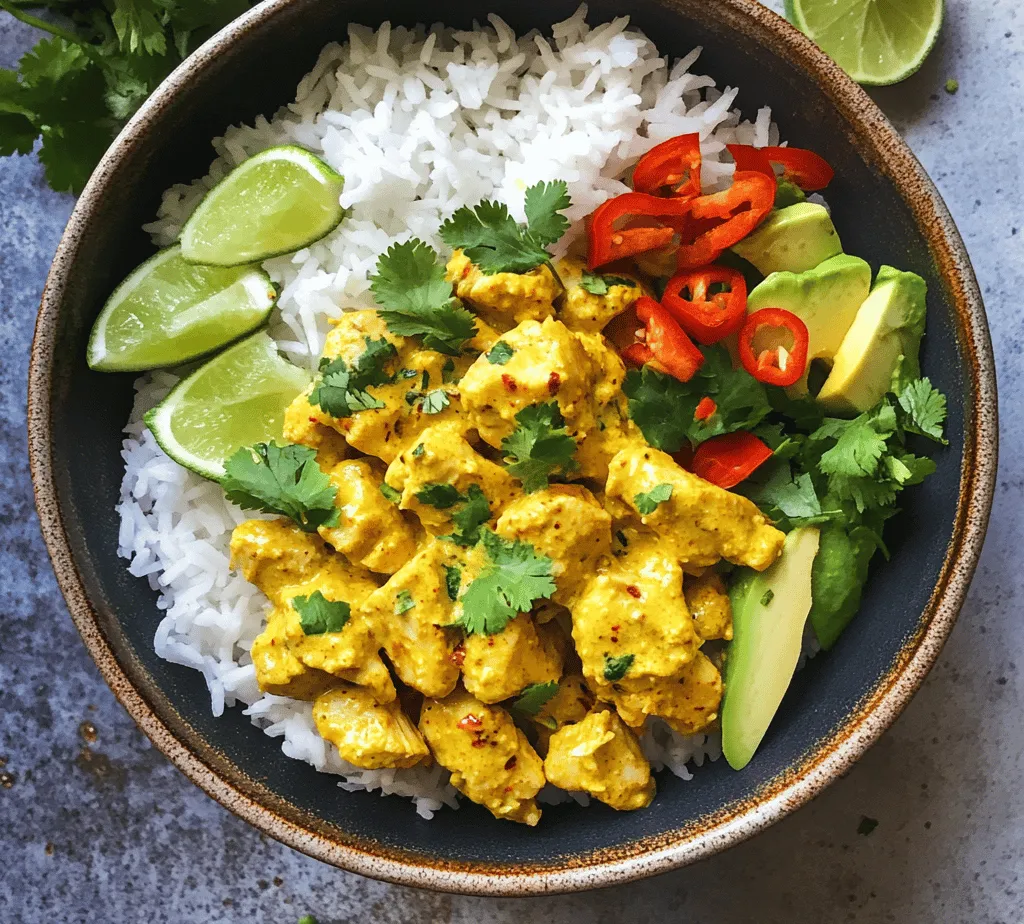Introduction
The Coconut Chicken Rice Bowl is a culinary masterpiece that brings together the comforting flavors of coconut and tender chicken, making it a popular dish in various cultures, particularly in Southeast Asia. This dish beautifully marries the sweet, rich essence of coconut milk with the savory notes of seasoned chicken, creating a meal that is both satisfying and nourishing. The Coconut Chicken Rice Bowl is more than just a meal; it is a celebration of vibrant flavors and diverse culinary traditions that highlight the use of fresh, wholesome ingredients.
This dish has gained significant popularity among health-conscious individuals and food enthusiasts alike. Its appeal lies in its versatility; you can customize it to suit your dietary preferences or creative whims. Whether you prefer a vegetarian version with tofu or a seafood twist with shrimp, the Coconut Chicken Rice Bowl can adapt to your taste, making it a delightful option for any occasion.
The Ingredients Behind the Flavor
Every great dish starts with quality ingredients, and the Coconut Chicken Rice Bowl is no exception. Understanding the role of each component not only enhances the flavor but also contributes to the nutritional value of the dish.
Jasmine Rice: Benefits and Cooking Tips
The foundation of the Coconut Chicken Rice Bowl is jasmine rice, a long-grain aromatic rice known for its delicate floral fragrance and slightly sticky texture when cooked. Rich in carbohydrates, jasmine rice provides a satisfying base that pairs perfectly with the creamy coconut sauce. It is also gluten-free, making it an excellent option for those with dietary restrictions.
When preparing jasmine rice, rinsing is key. Rinsing removes excess starch, preventing the rice from becoming gummy during cooking. To cook jasmine rice, use a 1:1.5 ratio of rice to water or chicken broth for added flavor. Bring the mixture to a boil, reduce the heat to low, cover, and simmer for about 15 minutes, or until the rice is tender and the liquid is absorbed.
Coconut Milk: Nutritional Value and Flavor Profile
Coconut milk is the star ingredient that elevates this dish, imparting a creamy texture and a rich, slightly sweet flavor. It is high in healthy fats, particularly medium-chain triglycerides (MCTs), which are known to provide quick energy and support heart health. Additionally, coconut milk is a good source of several essential vitamins and minerals, including manganese, copper, and selenium.
In the Coconut Chicken Rice Bowl, coconut milk serves not just as a flavor enhancer but also as a key ingredient in the cooking liquid for the rice, imparting a luscious creaminess that balances the savory elements of the dish.
Chicken Breast: Protein Source and Preparation Insights
Chicken breast is the primary protein source in this recipe, providing lean protein that is essential for muscle repair and overall health. Its mild flavor makes it the perfect canvas for absorbing the various spices and seasonings used in the dish.
To achieve tender, juicy chicken, start with high-quality boneless, skinless chicken breasts. Marinating the chicken in a mixture of soy sauce, garlic, and ginger enhances its flavor and ensures it remains moist during cooking. When sautéing the chicken, cook it over medium-high heat until golden brown and cooked through, aiming for an internal temperature of 165°F (75°C).
Olive Oil: Health Benefits and Cooking Properties
Olive oil is a staple in many kitchens for good reason. Rich in monounsaturated fats, it is known for its heart-healthy properties and helps to lower bad cholesterol levels. In the context of the Coconut Chicken Rice Bowl, olive oil serves as the cooking medium for sautéing the chicken, providing a light, fruity flavor that complements the dish without overpowering it.
When using olive oil, it’s essential to choose extra virgin olive oil for its superior flavor and health benefits. Heat it gently to avoid burning, which can impart a bitter taste to your dish.
Soy Sauce: Role in Seasoning and Balancing Flavors
Soy sauce is a fundamental seasoning in many Asian dishes, including the Coconut Chicken Rice Bowl. It adds a salty umami flavor that enhances the overall taste profile of the dish. The sodium content in soy sauce also helps to balance the sweetness of the coconut milk, creating a harmonious blend of flavors.
For a healthier option, consider using low-sodium soy sauce, which allows you to control the saltiness of the dish without sacrificing flavor.
Aromatics: Importance of Garlic and Ginger in Enhancing Taste
Garlic and ginger are the aromatic powerhouses that bring depth and warmth to the Coconut Chicken Rice Bowl. Garlic adds a pungent, savory note, while ginger contributes a spicy, zesty flavor that complements the richness of the coconut milk.
Incorporating these aromatics into the cooking process is crucial. Sautéing minced garlic and ginger in olive oil before adding the chicken releases their essential oils, enhancing the overall aroma and flavor of the dish. This step not only adds complexity but also creates a fragrant base that makes your kitchen smell irresistible.
Optional Toppings and Their Contributions
One of the best aspects of the Coconut Chicken Rice Bowl is its adaptability. While the core ingredients create a fantastic dish, optional toppings can elevate it further. Consider adding sliced green onions for a fresh crunch, chopped cilantro for a burst of herbaceous flavor, or roasted peanuts for a satisfying crunch.
Avocado slices can also bring a creamy texture that complements the coconut milk. Each topping contributes its unique flavor and texture, allowing you to personalize your bowl and make it your own.
Cooking the Perfect Coconut Rice
Now that we have explored the essential ingredients, it’s time to delve into the cooking process of the Coconut Chicken Rice Bowl. The first step in this delightful journey is preparing the coconut rice, which serves as the flavorful base for the dish.
Step-by-Step Guide on Rinsing and Cooking Jasmine Rice
To ensure that your jasmine rice is light and fluffy, begin by rinsing it under cold water. Place the rice in a fine-mesh sieve and run it under cold water until the water runs clear. This step is crucial in removing excess starch that can cause the rice to clump together.
Once rinsed, transfer the rice to a saucepan. Add the appropriate amount of coconut milk and chicken broth (or water) according to the ratio mentioned earlier. For added flavor, consider adding a pinch of salt or a small piece of pandan leaf if you have it on hand.
Importance of Removing Excess Starch
Removing excess starch is vital for achieving the perfect texture in your coconut rice. Starch can make the rice sticky and clumpy, which is not desirable in this dish. Rinsing the rice thoroughly ensures that it cooks evenly and achieves that desirable fluffy consistency.
Tips on Achieving Ideal Texture with Coconut Milk and Chicken Broth
For a richer flavor, mix coconut milk with chicken broth in your cooking liquid. This combination yields a wonderfully creamy texture that elevates the dish’s overall taste. Bring the mixture to a boil over medium-high heat, then reduce the heat to low, cover, and let it simmer gently. Avoid lifting the lid too often, as this will release steam and affect cooking time.
Techniques for Resting and Fluffing Rice for Optimal Serving
Once the rice has absorbed all the liquid and is fully cooked, remove it from the heat and let it rest, covered, for about 10 minutes. This resting period allows the rice to continue cooking in its own steam, ensuring that it is tender yet fluffy.
After resting, fluff the rice gently with a fork to separate the grains. This technique prevents the rice from becoming mushy and prepares it for serving. The result is a delightful bed of coconut-infused jasmine rice that perfectly complements the chicken and other flavors in the bowl.
Creating Flavorful Chicken
With the coconut rice prepared, it’s time to turn our attention to the chicken, the star protein of the Coconut Chicken Rice Bowl. Properly preparing the chicken will ensure that it is flavorful and tender, making every bite enjoyable.
The Process of Sautéing Chicken Breast
To start, heat a tablespoon of olive oil in a large skillet over medium-high heat. Once the oil is hot, add the marinated chicken breasts to the pan. Sauté the chicken for about 5-7 minutes on each side, or until golden brown and cooked through. It’s important not to overcrowd the pan, as this can cause the chicken to steam rather than sear, leading to a less desirable texture.
Importance of Seasoning and Timing in Achieving Tender Chicken
Proper seasoning is key to enhancing the natural flavors of the chicken. The marinade should already infuse the chicken with flavor; however, adding a sprinkle of salt and pepper during cooking can enhance its taste further. Timing is also essential—avoid overcooking the chicken, as this can lead to dryness. Using a meat thermometer to check for doneness can help you achieve perfectly cooked chicken every time.
How Turmeric and Cumin Contribute to the Dish’s Aroma and Color
To add depth of flavor and a beautiful golden hue to the chicken, consider incorporating spices such as turmeric and cumin. Turmeric not only provides a warm, earthy flavor but also offers antioxidant properties, while cumin adds a warm, nutty essence. Sprinkle these spices over the chicken during the last few minutes of cooking, allowing them to toast slightly in the skillet, which will enhance their flavors and fragrance.
Explanation of Integrating Aromatics
As the chicken cooks, it’s time to integrate the aromatics—garlic and ginger. Adding minced garlic and ginger to the pan during the last few minutes of cooking will release their essential oils, enveloping the chicken in a delightful aroma. This technique ensures that the flavors are well distributed and enhances the overall taste of the dish.
Cooking the Coconut Chicken Rice Bowl is not just about following a recipe; it’s about understanding the ingredients and techniques that create a harmonious, flavorful dish. With each step, from preparing the rice to sautéing the chicken, you are on your way to creating a comforting and nutritious meal that is sure to impress. Stay tuned for the next part, where we will explore the final touches and presentation of this delicious bowl.

Timing for Adding Soy Sauce and Lime Juice for Maximum Flavor Infusion
When preparing your Coconut Chicken Rice Bowl, timing is crucial for maximizing the flavors of the soy sauce and lime juice. As you heat the chicken in the coconut milk mixture, aim to add the soy sauce towards the end of the cooking process, right before removing the pan from the heat. This allows the soy sauce to blend seamlessly with the other flavors without overpowering the dish.
Incorporating lime juice should follow soon after; add it just before serving. This timing ensures that the vibrant acidity of the lime juice shines through, brightening up the dish and enhancing the overall flavor profile. Remember, the goal is to achieve a balanced harmony of savory, sweet, and tangy notes in your Coconut Chicken Rice Bowl.
Assembling Your Coconut Chicken Rice Bowl
Visual Appeal: Importance of Presentation in Home Cooking
The presentation of your Coconut Chicken Rice Bowl can elevate the dining experience considerably. A well-presented dish not only looks appetizing but also enhances the enjoyment of the meal. A beautifully arranged bowl can impress family and friends, making your cooking feel like a culinary masterpiece.
Tips for Layering
1. Starting with Rice as a Base: Begin by placing a generous serving of coconut-infused rice at the bottom of your bowl. This serves as the foundation and absorbs the flavors from the chicken and sauce above, creating a satisfying base.
2. Strategically Placing Chicken and Garnishes: Next, layer the chicken in a neat pile or slices on top of the rice. This not only makes the dish visually appealing but also allows guests to see the succulent pieces of chicken. Garnishes such as sliced green onions, cilantro, or sesame seeds can be sprinkled on top, adding pops of color and additional textures.
3. Discuss the Role of Garnishes and Additional Toppings: Garnishes play a critical role in both flavor and nutrition. Fresh herbs like cilantro or basil can brighten the dish, while crunchy toppings such as toasted coconut flakes or roasted nuts add texture. Additionally, consider adding fresh vegetables such as cucumber slices or shredded carrots for extra crunch and nutrition, making your bowl not only more delicious but also visually appealing.
Nutritional Benefits of the Coconut Chicken Rice Bowl
The Coconut Chicken Rice Bowl is not just a feast for the eyes; it also offers a multitude of nutritional benefits.
– Breakdown of Macronutrients from the Main Ingredients: The primary components of this dish—chicken breast, coconut milk, rice, and vegetables—provide a balanced array of macronutrients. Chicken breast is an excellent source of lean protein, crucial for muscle repair and growth. Coconut milk contributes healthy fats, particularly medium-chain triglycerides (MCTs), which can support energy levels and metabolism. The rice serves as a carbohydrate source, providing energy, while the vegetables add fiber and essential vitamins.
– Health Benefits of Coconut Milk and Chicken Breast: Coconut milk is rich in lauric acid, which may help boost immune function and support heart health. Chicken breast is low in fat and high in protein, making it an ideal choice for those looking to maintain a healthy diet.
– The Role of Fresh Vegetables in the Dish: Fresh vegetables not only add flavor but also provide essential nutrients. Incorporating a variety of colors into your bowl ensures you get a wide range of vitamins and minerals. For example, bell peppers are rich in vitamin C, while leafy greens provide iron and calcium.
– Discussion on Dietary Considerations: This recipe can easily accommodate different dietary needs. It is naturally gluten-free, as soy sauce alternatives can be used (such as tamari or coconut aminos) for those with gluten sensitivities. The dish is also dairy-free, making it suitable for lactose intolerant individuals.
Customizing Your Coconut Chicken Rice Bowl
One of the best aspects of the Coconut Chicken Rice Bowl is its versatility. Here are some suggestions for customizing the dish to suit your preferences:
– Suggestions for Ingredient Substitutions: If you’re looking for alternatives, consider using tofu or shrimp instead of chicken for a different protein source. Both options will absorb the flavors of the coconut milk, creating a deliciously unique bowl.
– Alternative Proteins: If you’re not keen on chicken, shrimp offers a quick-cooking option that pairs beautifully with the coconut flavors. For a heartier option, beef or lamb can also work well, but be mindful of the cooking times required for these proteins.
– Different Grains: While jasmine rice is a traditional choice, you can experiment with other grains like quinoa or brown rice for added nutrition and texture. Quinoa is a complete protein, making it a fantastic option for vegetarian or vegan diets.
– Flavor Variations with Spices and Herbs: For those who enjoy a bit of heat, consider adding chili flakes or fresh sliced chilies to your chicken during cooking. Alternatively, herbs like lemongrass or Thai basil can impart a fragrant twist to the dish.
– Adding Heat with Chili or Different Herbs for Unique Twists: Experimenting with different spices can also change the flavor profile significantly. Adding a teaspoon of curry powder or garam masala can provide a delightful warmth and complexity to your Coconut Chicken Rice Bowl.
Culinary Tips and Techniques for Success
To ensure your Coconut Chicken Rice Bowl turns out perfectly every time, consider these culinary tips:
– Common Mistakes to Avoid When Preparing the Dish: One common mistake is overcooking the chicken, which can lead to a dry texture. Always monitor the cooking time and remove the chicken from the heat as soon as it reaches an internal temperature of 165°F (75°C).
– Best Practices for Meal Prep and Storage: This dish is ideal for meal prep. You can prepare the chicken and rice in advance and store them separately. When stored properly in airtight containers, the cooked chicken and rice can last in the refrigerator for up to four days.
– How to Reheat Leftovers Without Compromising Texture: When reheating, consider using a microwave with a cover to retain moisture or reheat on the stovetop with a splash of water or coconut milk to prevent drying out. This helps maintain the creamy texture of the coconut sauce and the tenderness of the chicken.
Conclusion
The Coconut Chicken Rice Bowl is a delightful dish that combines flavor, nutrition, and visual appeal, making it a perfect meal for any occasion. Its versatility allows for endless customization, whether you’re looking to switch up the protein, grains, or flavor profiles.
Encouraging experimentation with the recipe will not only help you find your perfect combination of ingredients but will also make cooking more enjoyable. So roll up your sleeves, gather your ingredients, and prepare to create a wholesome, satisfying meal that is sure to impress family and friends alike. The beauty of the Coconut Chicken Rice Bowl lies in its ability to adapt to your tastes while providing a delicious and nourishing experience.



